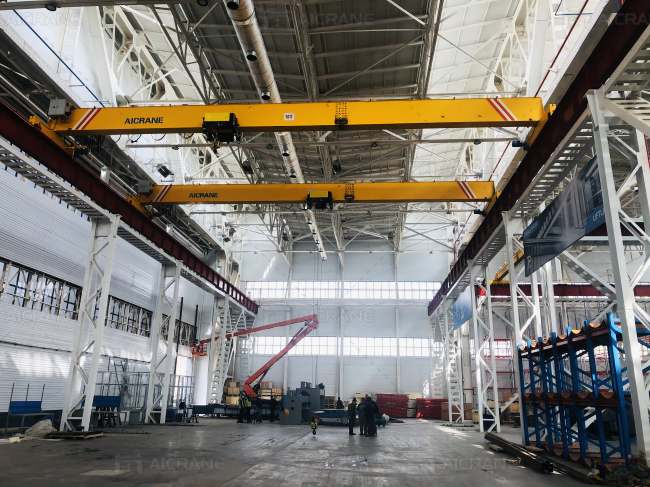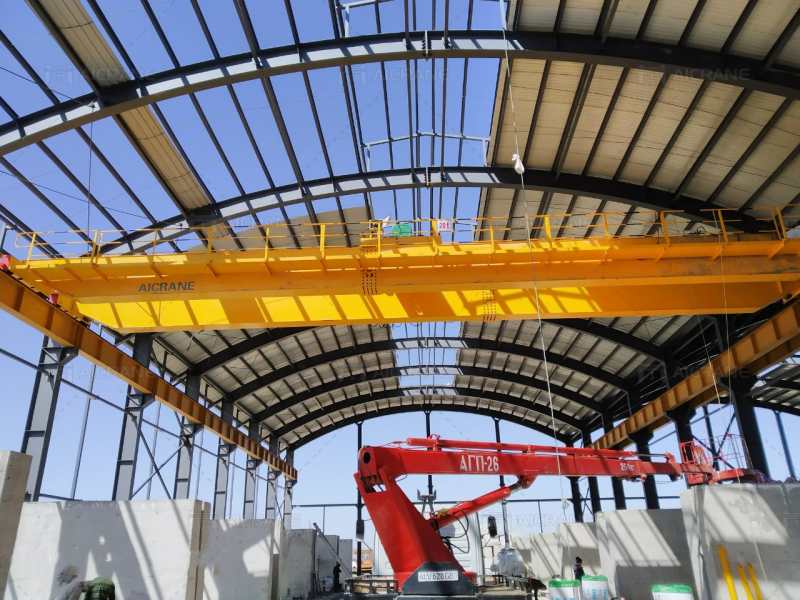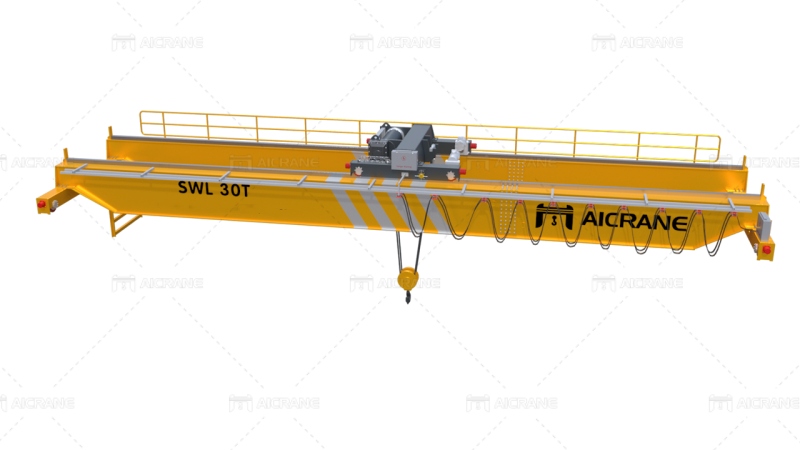Top running overhead cranes are widely used in industries such as manufacturing, warehousing, and construction to lift and move heavy loads efficiently. Unlike under-running cranes, which travel on the bottom flange of the runway beam, top running overhead cranes operate on rails mounted on the top of the runway beams, allowing them to handle larger loads and travel longer distances. Properly setting up a top running overhead crane system is essential to ensure operational efficiency, safety, and longevity of the equipment. This guide will walk you through the key steps for planning, installing, and maintaining a top running overhead crane system.

Assessing Your Facility’s Needs
Before purchasing or setting up a top running overhead crane system, it’s crucial to assess the specific requirements of your facility. Here are the main factors to consider:
A. Load Capacity
Determine the maximum weight your crane will need to lift. Top running cranes are suitable for heavy-duty applications and can handle large capacities, typically ranging from 1 ton to over 100 tons. Choose an overhead crane with a load capacity that matches or slightly exceeds your heaviest lifting needs to ensure safety and efficiency.
B. Span and Lifting Height
The span refers to the distance between the runway beams, while the lifting height is the distance from the ground to the crane’s hook when fully extended. Measure these dimensions accurately, as they will dictate the size and configuration of your crane system. Ensure the crane’s lifting height is sufficient for your specific operations without exceeding your facility’s vertical clearance.
C. Operational Environment
Consider the environment in which the crane will operate. For example, outdoor applications may require weather-resistant materials, while environments with high temperatures, moisture, or chemicals may demand specialized coatings or features. If your crane will be used in an area with high traffic or a confined space, you may need to invest in additional safety or automation features.

Designing the Crane System
Once you’ve assessed your needs, the next step is to design a crane system that aligns with your facility’s layout and operational requirements. This involves selecting the appropriate components and configuration for optimal performance.
A. Choosing the Crane Type
There are several types of top running cranes, including:
- Single Girder Cranes: These cranes feature a single bridge beam and are typically used for lighter applications. They are more affordable and easier to install but have lower load capacities.
- Double Girder Cranes: These have two bridge beams, known as large overhead crane, allowing them to support higher loads and offer greater lifting heights. They are ideal for heavy-duty applications but require more structural support.
B. Selecting the Hoist
The hoist is responsible for lifting and lowering the load. When choosing a hoist, consider factors like:
- Type: Electric hoists are common for top running cranes due to their power and ease of use. Manual or pneumatic hoists may be used in specialized applications.
- Speed: Consider the speed at which the hoist lifts and lowers loads. Higher speeds improve productivity but may increase wear and tear on the crane.
- Duty Cycle: If your operations involve frequent lifting, choose a hoist with a high-duty cycle rating to ensure durability and consistent performance.
C. Runway System
The crane’s runway system is critical for ensuring smooth travel along the facility. This includes:
- Runway Beams: Typically made of steel, runway beams support the crane’s weight and provide a stable path for its movement.
- Rails: Rails must be installed on top of the runway beams to guide the crane’s movement. Proper alignment and installation are essential to prevent excessive wear and ensure smooth operation.

Installing the Crane System
Proper installation is critical to ensure the safe and efficient operation of your top running overhead crane. Follow these steps for a successful installation:
A. Hiring a Qualified Installation Team
Overhead crane installation should be handled by qualified professionals with experience in crane setup. Improper installation can lead to safety hazards, poor performance, and costly downtime. Ensure the team is certified and follows all safety regulations.
B. Foundation Preparation
The structural integrity of your facility’s foundation is crucial for supporting the weight of the crane and its load. Inspect the foundation and, if necessary, reinforce it to handle the additional stresses imposed by the crane system. Proper alignment and leveling of the runway beams are critical for the smooth operation of the crane.
C. Electrical and Control Systems
Your top running overhead crane will require electrical wiring and controls for operation. Make sure that the electrical system is installed correctly, and all components, such as limit switches and emergency stops, are functioning properly. The control system should be user-friendly, with clear indicators and safety features like overload protection and emergency stops.
Aicrane, as a reputable crane manufacturer and supplier, offers both quality equipment and reliable services, if you want to know more about the lifting equipment and get a reliable solution for your business, you can feel free to contact Aicrane Group team now.
Testing and Commissioning
Once the crane system is installed, it’s essential to test and commission the crane to ensure everything works correctly. The installation team should conduct load tests, speed tests, and operational checks to verify that the crane meets its design specifications.
- Load Test: Test the crane’s lifting capacity by lifting a load that meets or exceeds its rated capacity.
- Safety Check: Verify that all safety features, such as limit switches, brakes, and emergency stops, are working properly.
- Operational Test: Check the smoothness of the crane’s movement along the rails and its response to control commands.
Ongoing Maintenance and Inspections
Regular maintenance is vital to keep your top running overhead crane system in peak condition and to prevent accidents or costly repairs. Develop a maintenance schedule that includes:
- Daily Inspections: Operators should perform visual checks before each shift, looking for signs of wear, misalignment, or damage.
- Routine Maintenance: Schedule regular lubrication, alignment checks, and inspections of components such as the hoist, rails, and electrical systems.
- Annual Inspections: Conduct comprehensive inspections annually to ensure the crane complies with safety standards and to identify any long-term issues.
Setting up a top running overhead crane system involves careful planning, design, and installation. By assessing your facility’s needs, selecting the right components, ensuring professional installation, and maintaining the crane system, you can ensure safe and efficient operations. A properly set up top running overhead crane can significantly boost productivity while providing a reliable and durable solution for your material handling needs.
